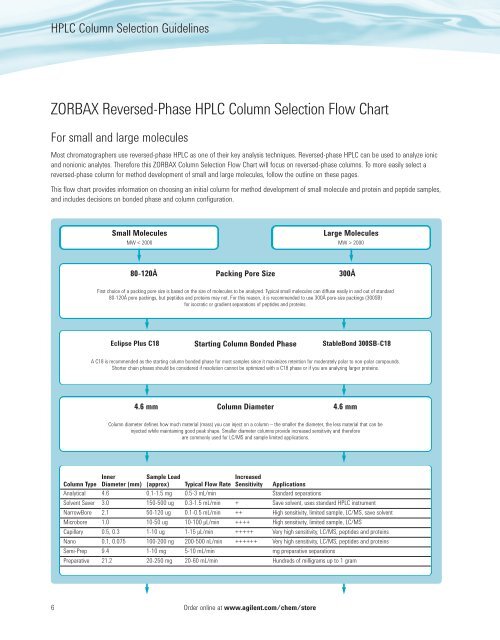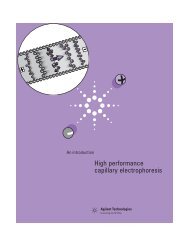Create successful ePaper yourself
Turn your PDF publications into a flip-book with our unique Google optimized e-Paper software.
<strong>HPLC</strong> <strong>Column</strong> <strong>Selection</strong> <strong>Guide</strong>linesZORBAX Reversed-Phase <strong>HPLC</strong> <strong>Column</strong> <strong>Selection</strong> Flow ChartFor small and large moleculesMost chromatographers use reversed-phase <strong>HPLC</strong> as one of their key analysis techniques. Reversed-phase <strong>HPLC</strong> can be used to analyze ionicand nonionic analytes. Therefore this ZORBAX <strong>Column</strong> <strong>Selection</strong> Flow Chart will focus on reversed-phase columns. To more easily select areversed-phase column for method development of small and large molecules, follow the outline on these pages.This flow chart provides information on choosing an initial column for method development of small molecule and protein and peptide samples,and includes decisions on bonded phase and column configuration.Small MoleculesMW < 2000Large MoleculesMW > 200080-120ÅPacking Pore Size300ÅFirst choice of a packing pore size is based on the size of molecules to be analyzed. Typical small molecules can diffuse easily in and out of standard80-120Å pore packings, but peptides and proteins may not. For this reason, it is recommended to use 300Å pore-size packings (300SB)for isocratic or gradient separations of peptides and proteins.Eclipse Plus C18Starting <strong>Column</strong> Bonded PhaseStableBond 300SB-C18A C18 is recommended as the starting column bonded phase for most samples since it maximizes retention for moderately polar to non-polar compounds.Shorter chain phases should be considered if resolution cannot be optimized with a C18 phase or if you are analyzing larger proteins.4.6 mm<strong>Column</strong> Diameter4.6 mm<strong>Column</strong> diameter defines how much material (mass) you can inject on a column – the smaller the diameter, the less material that can beinjected while maintaining good peak shape. Smaller diameter columns provide increased sensitivity and thereforeare commonly used for LC/MS and sample limited applications.<strong>Column</strong> TypeInnerDiameter (mm)Sample Load(approx) Typical Flow RateIncreasedSensitivity ApplicationsAnalytical 4.6 0.1-1.5 mg 0.5-3 mL/min Standard separationsSolvent Saver 3.0 150-500 ug 0.3-1.5 mL/min + Save solvent, uses standard <strong>HPLC</strong> instrumentNarrowBore 2.1 50-120 ug 0.1-0.5 mL/min ++ High sensitivity, limited sample, LC/MS, save solventMicrobore 1.0 10-50 ug 10-100 µL/min ++++ High sensitivity, limited sample, LC/MSCapillary 0.5, 0.3 1-10 ug 1-15 µL/min +++++ Very high sensitivity, LC/MS, peptides and proteinsNano 0.1, 0.075 100-200 ng 200-500 nL/min ++++++ Very high sensitivity, LC/MS, peptides and proteinsSemi-Prep 9.4 1-10 mg 5-10 mL/min mg preparative separationsPreparative 21.2 20-250 mg 20-60 mL/min Hundreds of milligrams up to 1 gram6 Order online at www.agilent.com/chem/store
















